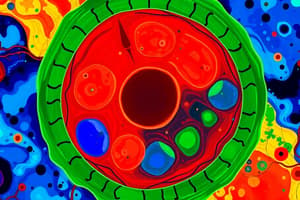Podcast
Questions and Answers
What is the function of the cell membrane?
What is the function of the cell membrane?
A selectively permeable boundary that separates the cell from its environment and protects it from external factors.
Describe the function of cytoplasm.
Describe the function of cytoplasm.
A jelly-like substance inside the cell membrane containing various organelles and other cellular components.
What is metabolism in the context of cells?
What is metabolism in the context of cells?
The process by which cells convert nutrients into energy and maintain their internal environment.
Differentiate between prokaryotic and eukaryotic cells.
Differentiate between prokaryotic and eukaryotic cells.
Explain the process of cell growth.
Explain the process of cell growth.
What is the function of the Golgi Apparatus in a eukaryotic cell?
What is the function of the Golgi Apparatus in a eukaryotic cell?
Where is the genetic material (DNA) of a eukaryotic cell typically located?
Where is the genetic material (DNA) of a eukaryotic cell typically located?
What is the primary function of mitochondria in a cell?
What is the primary function of mitochondria in a cell?
Which organelles are responsible for carrying out photosynthesis in plant cells?
Which organelles are responsible for carrying out photosynthesis in plant cells?
Describe the process through which cells reproduce and produce genetically identical daughter cells.
Describe the process through which cells reproduce and produce genetically identical daughter cells.
Flashcards
What is the cell membrane?
What is the cell membrane?
A selectively permeable membrane that separates the cell from its environment and protects it from external factors.
What is the cytoplasm?
What is the cytoplasm?
A jelly-like substance inside the cell membrane containing various organelles and other cellular components.
What is metabolism?
What is metabolism?
The process by which cells convert nutrients into energy and maintain their internal environment.
What is growth in cells?
What is growth in cells?
Signup and view all the flashcards
What is cell repair?
What is cell repair?
Signup and view all the flashcards
What is cell communication?
What is cell communication?
Signup and view all the flashcards
What are prokaryotic cells?
What are prokaryotic cells?
Signup and view all the flashcards
What are eukaryotic cells?
What are eukaryotic cells?
Signup and view all the flashcards
What is the nucleus in a cell?
What is the nucleus in a cell?
Signup and view all the flashcards
What are mitochondria?
What are mitochondria?
Signup and view all the flashcards
Study Notes
Exploring the Fascinating World of Cells
At the heart of every living organism, from the tiniest microbe to the most complex multicellular life form, lie the fundamental building blocks known as cells. In this article, we'll dive into the intricate details of cell structure, functions, types, organelles, and reproduction to better understand the fundamental units that make up life as we know it.
Cell Structure
Cells come in various shapes and sizes, but they share a few basic structures that allow them to carry out their essential functions.
- Cell membrane: A selectively permeable boundary that separates the cell from its environment and protects it from external factors.
- Cytoplasm: A jelly-like substance inside the cell membrane containing various organelles and other cellular components.
Cell Functions
Cells carry out essential functions such as:
- Metabolism: The process by which cells convert nutrients into energy and maintain their internal environment.
- Growth: The process by which cells increase in size through the synthesis of new cellular components.
- Repair: The process by which cells repair damage to their internal structures.
- Communication: The process by which cells communicate and coordinate with other cells.
Cell Types
Despite their shared fundamental structures, cells can be categorized into several types:
- Prokaryotic cells: Lacking organelles, simple in structure, and found mainly in bacteria and archaea.
- Eukaryotic cells: Containing organelles and found mainly in plants, animals, fungi, and protists.
Cell Organelles
Eukaryotic cells contain specialized structures called organelles, which help them carry out specific functions.
- Nucleus: The control center of the cell, containing the cell's genetic material (DNA) and regulating gene expression.
- Mitochondria: The cell's energy powerhouses, producing ATP, the cell's primary energy currency.
- Endoplasmic Reticulum (ER): A network of membranous tubules and sacs involved in protein synthesis and lipid production.
- Golgi Apparatus: A series of flattened, membrane-bound sacs that modify and package proteins and lipids for transport outside the cell.
- Lysosomes: Organelles containing digestive enzymes that break down waste materials and damaged cellular components.
- Chloroplasts: Found only in plant cells, these organelles carry out photosynthesis, producing glucose and oxygen from sunlight, carbon dioxide, and water.
Cell Reproduction
Cells reproduce through a process called cell division or mitosis, producing genetically identical daughter cells. During this process, a single parent cell divides into two new cells, each containing the same genetic material.
In summary, cells are the fundamental building blocks of life, their structures and functions are essential for life to exist, and their various types and organelles allow them to carry out diverse tasks and functions. Understanding these basic principles provides the foundation for exploring more advanced concepts in biology, medicine, and other fields.
Studying That Suits You
Use AI to generate personalized quizzes and flashcards to suit your learning preferences.




